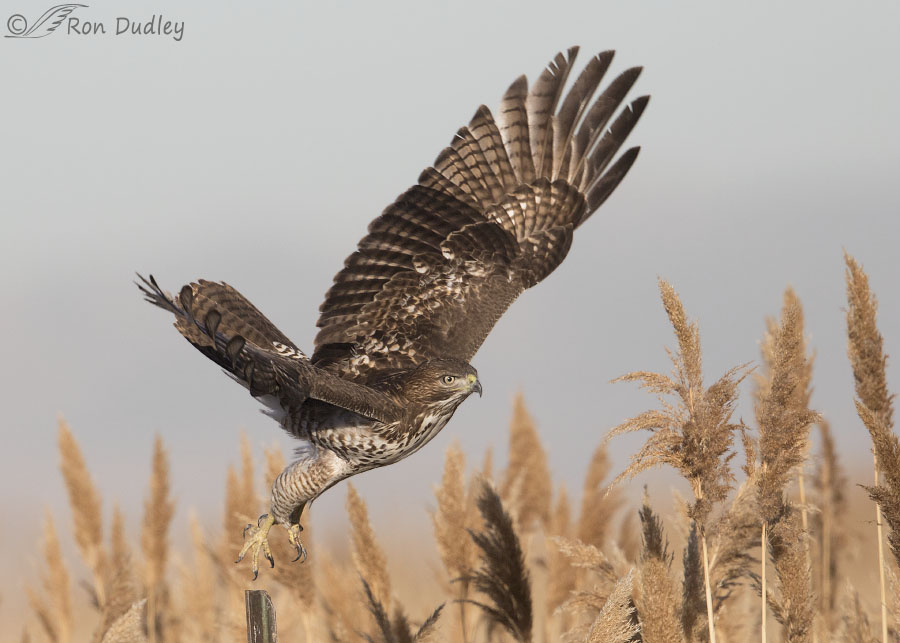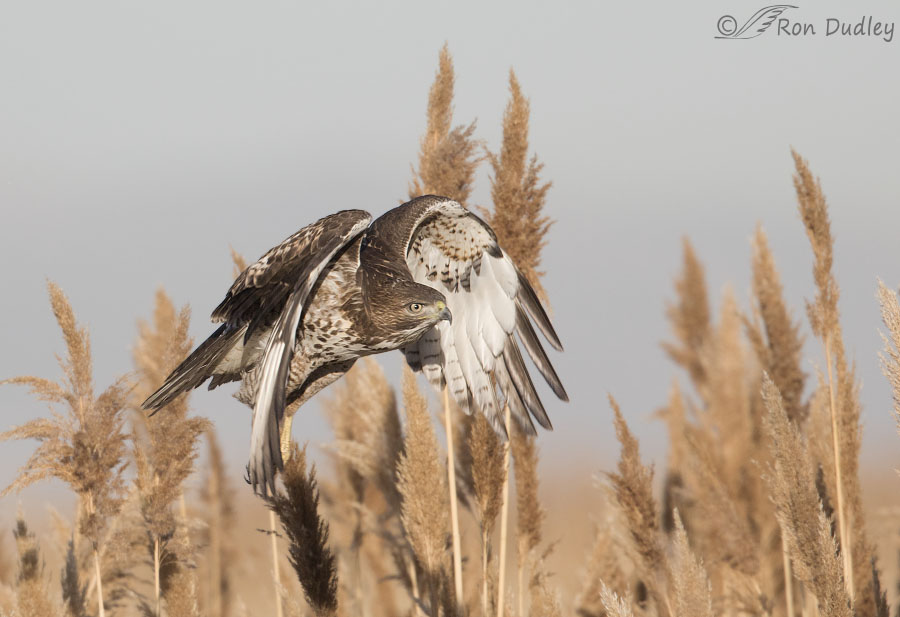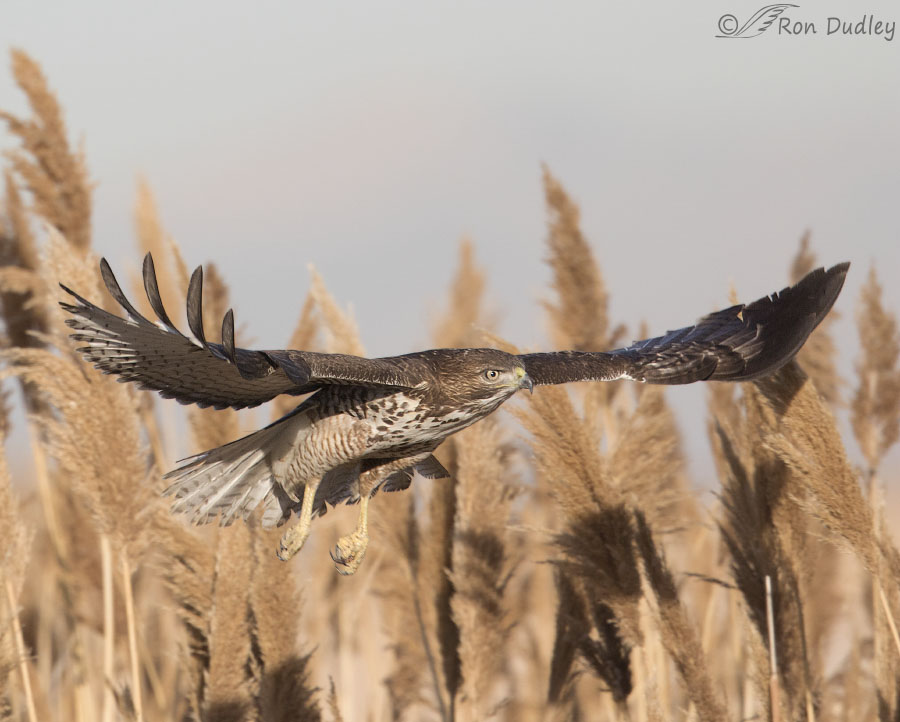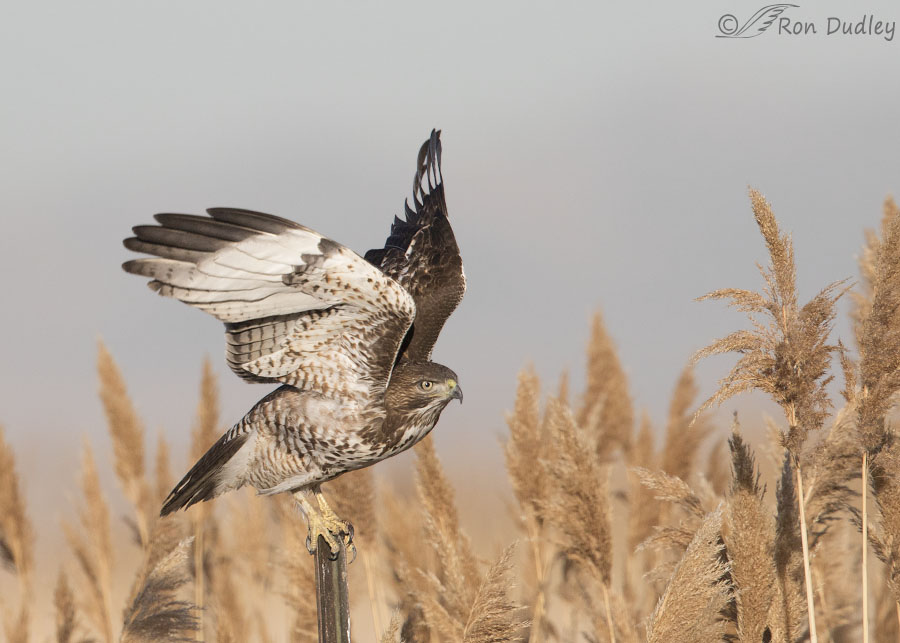Plus a bad photography habit I can’t completely shake.
Yesterday morning at Farmington Bay WMA I finally had a cooperative bird and good light at the same time. It’s been a while so I was extremely disappointed when I botched part of the opportunity.
1/3200, f/6.3, ISO 400, Canon 7D Mark II, Canon EF 500mm f/4L IS II USM + EF 1.4 III Extender, not baited, set up or called in
The bird was an immature Red-tailed Hawk with a stand of phragmites directly behind it and those phrags may have helped to guide it in a perfect direction for good light and eye contact during liftoff and flight.

1/2500, f/6.3, ISO 400, Canon 7D Mark II, Canon EF 500mm f/4L IS II USM + EF 1.4 III Extender, not baited, set up or called in
I like this dynamic posture at the moment of launch.

1/2500, f/6.3, ISO 400, Canon 7D Mark II, Canon EF 500mm f/4L IS II USM + EF 1.4 III Extender, not baited, set up or called in
Although the phrags were quite close to the bird I like having them back there instead of just homogenous sky.

1/2000, f/6.3, ISO 400, Canon 7D Mark II, Canon EF 500mm f/4L IS II USM + EF 1.4 III Extender, not baited, set up or called in
This might be my favorite photo in the series, partly because I like the flight posture, the hawk’s look of concentration and I think the shadows of the bird on the phrags add interest.
There’s only four shots in the series because I screwed up. I had my lens on this bird for almost nine minutes before it took off and when it finally did I jerked my lens in response to the sudden action which made me lose sharp focus on the hawk or clip body parts in many photos in the series.
Sometimes I sit on a bird for a half hour or more before it takes off and during that time the tension builds because birds are fast at liftoff and at these focal lengths it’s hard to keep them in frame and in focus after they leave the perch. You really have to concentrate! Jerking the lens in response to a long-awaited launch is a natural reaction that photographers have to resist because doing so ruins so many images. It’s a bad habit that I was often guilty of when I first started photographing birds but thankfully I’ve learned to resist that nasty impulse most of the time. But this time I reverted to my old ways and paid the inevitable price. I had to delete about seven shots in the series because they were soft or body parts were clipped. Or both.
Birds don’t give us a do-over in situations like this so I’ll be kickin’ my butt for a while over this one.
Ron



What a magnificent bird! So glad you were successful in getting these shots.
I especially like the 2nd photo with the wing spread out like a beautiful fan. I also like the position of the feet with those impressive looking talons. I was surprised to learn that the wing span is 4 feet and that the average weight is 3 pounds.
Ron, thank you for these beautiful photos.
I’m glad you enjoyed them, Alice. Thanks.
OK, you know you have me with a redtail I swear my heart takes flight each time they lift off. What an unmitigated joy it is to be a part of their lives, however small.
I swear my heart takes flight each time they lift off. What an unmitigated joy it is to be a part of their lives, however small.
The local redtails have started their mating rituals here. Those flights are THE most erotic thing I’ve ever seen and the locals gifted me with a flight day before yesterday (or was it Saturday?). Just AMAZING!
As for jerking the camera at the strategic moment, all those mistakes just prove you’re human and ca-ca happens with amazing regularity. But look on the bright side–you captured four spectacular images. And that’s kinda like striking a gold mine in MY world! When I’m using a camera, one that’s much smaller, lighter and less powerful than yours, I ALWAYS jerk the camera downward. Just be content you’re not me
Laura, I saw a pair of mating kestrels this morning. In January. Seems pretty early to me for around here, even for most raptors.
Yeah, for your area, that does seem to be pretty early, but to be fair, it’s almost February. For here, the redtails are pretty much right on schedule (I think). This is my first winter here, so I don’t yet have the rhythms of this place saved in my soul, but I would guess they’d want to avoid the worst of the heat with the kiddos. In New York, the Cornell redtails produced their first egg around St. Patrick’s Day (well before winter ends there). Not sure what all that means, but there it is.
And thank you for the redtail images. They’re just so SPECIAL (in MY world)!
Great shots. Especially that last one! It’s nice to hear about the ups and downs of bird photography and to know that even with your expertise and talent things can go wrong. Newbie that I am, I have that same bad habit. But I do it almost every time the action gets exciting! So I’m constantly kicking myself
Bird photographers need resilient butts!
Thanks for keeping it real, Ron. The balance between success and failure that you share with the rest of us concerning your photographic experiences makes your blog both interesting and inspiring.
I have plenty of “real” to share, Robert. My failures far outnumber my successes!
Don’t kick yourself too hard; that last photo is breathtaking!! GrayGhostPhotography had the same issue on their mind today, “One of the big challenges with photographing Great Grey Owls is that they can sit still on a post for hours and then burst into flight in less than a second.”
Yup, that’s a problem with photographing takeoffs with any raptor species. Smaller birds usually don’t perch that long. Thank you, Gail.
Ron, great shots as usual! My favorite is the full wing extension right at take off. I have some shots like that of Eagles which I love. In comparing your Red Tail with shots I have of Eastern birds I notice significant color differences most likely due to age. I was wondering if you have done a photographic age time-line for Red Tails as you did for Eagles? I have referred to your guide many times to age various Eagles I have photographed and I am currently monitoring an Eagle nest for the NY DEC so I hope to get to use it again if the pair produce this season.
Please let me know if there is a similar Red Tail guide which would also be helpful.
Keep up the great work on your blog, I enjoy your photography and bird behavior discussion every morning.
Reid
Reid, I don’t know of a photographic guide exactly like you describe but Jerry Ligouri’s book “Hawks From Every Angle” comes pretty close.
There’s both an eastern and western race of Red-tails. Eastern birds occur only as light morphs but western birds occur as light, intermediate and dark morphs. Perhaps that’s at least part of what you’re observing instead of it being an age factor?
Thanks Ron, I will look for that book.
Another wonderful series, Ron. I recall having the same problem when coaching kids in baseball. One summer there was a first baseman who’d turn his back on his base between plays and gaze into the outfield. I kept telling him to keep his head in the game. Never seemed to get through. So at a winter coach training class on the mental game of baseball, I asked the instructor what to do to get him to stay focused. He had many years of experience and written a very popular sports psychology book, so I was sure he’d have a good tip. He did. But it wasn’t for the player. It was for me. He said that all of us can usually only bring ourselves into real focus for a very brief time, and for less than a second or two when the situation requires for an immediate response — such as batting a pitched ball. If we try to stay in focus for too long, we can’t be nearly as responsive. He said that the first baseman was doing a great focus relaxation excercise by turning away from the action and then bringing his mind back into the game just when the ball was pitched. After that I tried coaching getting your mind out of the situation with players and myself and it seemed to work – not all the time but definitely saw improvements. Of course we missed some things because we were distracted, but we generally did much better in our responses for those brief moments when we really needed to be attentive.
Your instructor was EXACTLY right about focus and concentration, Kent. I find myself doing the same thing when I’m on a bird. Intense concentration can’t be maintained for very long so whenever the bird does something (preens briefly, stands on one foot etc) indicating that takeoff isn’t imminent I give myself a brief mental break. It doesn’t always work but usually it does and I don’t miss the takeoff.
Thanks for that spot-on insight.
Tthis is such a great series I can only wonder what you feel you may have missed…I always like what I call the “fling” shots, where they fling their wings high just before the powerful downstroke of lift off, but these are all so great I can’t really pick a favorite…
“I can only wonder what you feel you may have missed”
That’s the problem, Patty. I CAN see what I missed in the clipped or soft shots so it really burns my butt because some of them would have been very nice. Thank you.
Unfortunately I know too well, how “the shot that was missed” can haunt you….I missed a shot, taken through pouring rain on my windshield, of a snow scene and a red/orange snow fence that haunts me to this day. Lens cap left on, card too full, dead batteries, the subject suddenly flew away, some one stepped in front of me, etc. it all hurts and haunts…too many “if onlies” …sorry it even happens to you.
The last one is lovely. And I hear you on kicking yourself over the missed ones. But you got some lovely ones!
Thank you, Arwen.
I especially enjoy pictures when the wings are bent, I have some of eagles like that, it really shows what the wings do.
I enjoy those kinds of shots too, Steven.
Very nice Ron. You have a habit of catching birds a the right moment. That is a lot of work and time. Thank you for sharing your talent.
Brian
Thanks, Brian. I have a lot of “habits”, some I like and some I don’t.
Ron: Any good photo of a bird in action is fantastic. In your case, skill, knowledge of birds, knowing your camera equipment, and lots of patience added up to four very nice images and a few lessons. End of a very nice story, a story that you are kind enough to share with your fans every day. Thank you.
Richard, I guess I should be glad I got this many nice shots of the hawk in flight. But I can’t help but think about what could have been…
Whether it’s the “Jerk” at liftoff, leading to much (seldom) or trailing too much (often), getting the bird in the right position in the frame and sharp throughout with good light and minimal shadows is the challenge. What are the odds of all that happpening on a regular basis? For me, very low. So hence, the quest. I could only be so lucky, at my age, to get my percentage of keepers above 20% for BIF. I can only hope! Great stuff here again Ron.
Thanks, Frank. My average keeper percentage hovers right around 10%, in flight or not. You’re absolutely correct, with birds lots of things have to go right to get nice images.
I think the keepage % would be higher for us mere mortals, though. I’m sure that even your worst shots are better than my best.
I’m sure that even your worst shots are better than my best.
Some of them, maybe. Most are pretty damned awful.
Uh huh, Ron. I believe you. There are THOUSANDS who wouldn’t, but I believe you (said tongue firmly in cheek)!
Gorgeous series Ron! All the colors of the phragmites and the hawk work beautifully! Hard to chose a “favorite” between 2 and 4……..:) Been there, done that, on jerking the lens after waiting awhile for a take off……. sigh…. Glad you were finally able to get out there and capture some lovely photos in “good” light….:)
Thanks, Judy. I think it happens to all bird photographers but that doesn’t make it any easier to take when it happens to ME!
These are pretty spectacular — jerks and all.
Thanks, Marty. Getting a few is better than nothing at all…